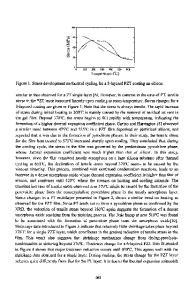Uniformity, composition, and surface tension in solution deposited PbZr x Ti 1-x O 3 films
- PDF / 426,650 Bytes
- 10 Pages / 612 x 792 pts (letter) Page_size
- 57 Downloads / 334 Views
High quality, uniform PbZrxTi1-xO3 (PZT) films were prepared on the 4 inch wafers by chemical solution deposition (CSD) of 1,3-propanediol precursors. Film uniformity was studied as a function of deposition conditions including spinning rates and co-solvents. Measurements of the surface tension and composition evolution during evaporation and spinning stages showed that the surface tension increases significantly when the co-solvent is nearly completely evaporated. The evaporation of the propanol co-solvent and volatile by-products occurs within the first 5 s of spinning giving rise to defects, whereas octanol is slowly evaporated during 60 s producing uniform coatings. Other co-solvents such as hexanol and pentanol produced uniform films as well. Therefore stabilization of the surface tension in the initial spinning stage is a key to prevent the defect formation. These findings facilitate the deposition of uniform PZT films over large substrates by a simple, scalable, and cost-effective process.
I. INTRODUCTION
Materials such as PbZrxTi1-xO3 (PZT) are the core of various devices such as sensors, actuators, motors, and non-volatile memory owing to their excellent piezoelectric, pyroelectic, and ferroelectric properties.1 The integration of these materials into devices is done by a film deposition on wafers with consecutive pattering and etching procedures that define the device shape. The film deposition method that is successfully used at an intermediate thickness of 0.5–2 m is Chemical Solution Deposition (CSD) because it allows easy stoichiometry control and fast economical processing at low temperatures and large coating area.2 The stoichiometry is controlled by a precise dosing of raw materials that provide the needed composition. The typical raw materials in the synthesis of the PZT precursor are lead acetate trihydrate, zirconium acetylacetonate, and titanium iso-propoxide. Three different synthesis procedures employing methoxyethanol3, acetic acid,4 and 1,3-propanediol5 (Diol) as a solvents have been reported. The Diol route, first reported by Phillips, Calzada, and Milne, appears to be optimal because it allows preparation of thicker films (up to 1 m thick), in a single step whereas other routes demand many repetitive steps. In addition Diol is a non-toxic solvent and the resulting precursor does not hydrolyze in a humid atmosphere.6,7
a)
Address all correspondence to this author. e-mail: [email protected] DOI: 10.1557/JMR.2007.0006 J. Mater. Res., Vol. 22, No. 1, Jan 2007
http://journals.cambridge.org
Downloaded: 14 Mar 2015
Therefore processing via the Diol route is simpler and more robust and provides longer precursor shelf life than alternative routes. However, the Diol-based PZT films prepared by a standard procedure5 are not sufficiently uniform, as reported by the method inventors.8 As shown later, large macro-defects such as striations, bubbles, and comets with size of ∼1 mm are formed during spin coating with corresponding film thickness variations of up to 200 nm. The defects spac
Data Loading...











